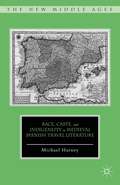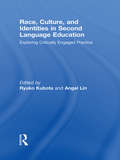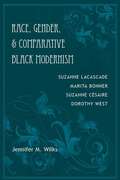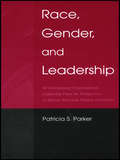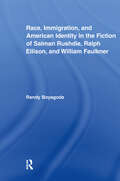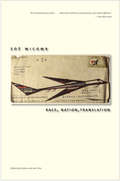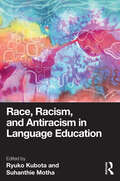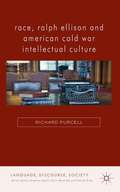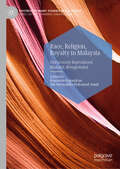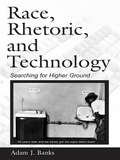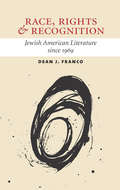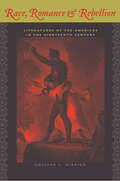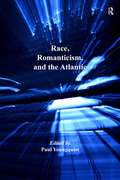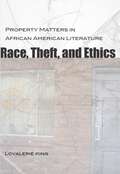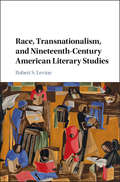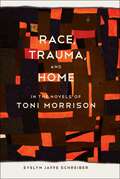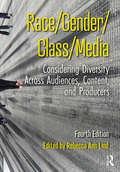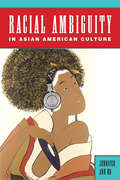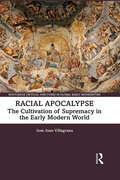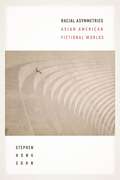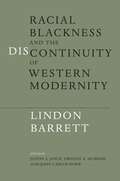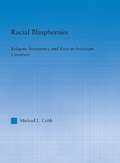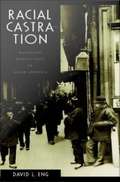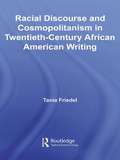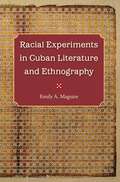- Table View
- List View
Race, Caste, and Indigeneity in Medieval Spanish Travel Literature (The New Middle Ages)
by M. HarneyThe origins of present-day Ibero-American racialization can be traced to the period when Europe straddled the boundary between the Middle Ages and the era of New World exploration. Focusing on themes of race, caste, and indigeneity in travel narratives, Harney explores this already internationalized world of late-medieval and early-modern Europe.
Race, Culture, and Identities in Second Language Education: Exploring Critically Engaged Practice
by Ryuko KubotaThe concept and construct of race is often implicitly yet profoundly connected to issues of culture and identity. Meeting an urgent need for empirical and conceptual research that specifically explores critical issues of race, culture, and identities in second language education, the key questions addressed in this groundbreaking volume are these: How are issues of race relevant to second language education? How does whiteness influence students’ and teachers’ sense of self and instructional practices? How do discourses of racialization influence the construction of student identities and subjectivities? How do discourses on race, such as colorblindness, influence classroom practices, educational interventions, and parental involvement? How can teachers transform the status quo? Each chapter is grounded in theory and provides implications for engaged practice. Topics cover a wide range of themes that emerge from various pedagogical contexts. Authors from diverse racial/ethnic/cultural backgrounds and geopolitical locations include both established and beginning scholars in the field, making the content vibrant and stimulating. Pre-reading Questions and Discussion Questions in each chapter facilitate comprehension and encourage dialogue.
Race, Gender, and Comparative Black Modernism: Suzanne Lacascade, Marita Bonner, Suzanne Césaire, Dorothy West
by Jennifer M. WilksRace, Gender, and Comparative Black Modernism revives and critiques four African American and Francophone Caribbean women writers sometimes overlooked in discussions of early-twentieth-century literature: Guadeloupean Suzanne Lacascade (dates unknown), African American Marita Bonner (1899--1971), Martinican Suzanne Césaire (1913--1966), and African American Dorothy West (1907--1998). Reexamining their most significant work, Jennifer M. Wilks demonstrates how their writing challenges prevailing racial archetypes -- such as the New Negro and the Negritude hero -- of the period from the 1920s to the 1940s, and explores how these writers tapped into modernist currents from expressionism to surrealism to produce progressive treatments of race, gender, and nation that differed from those of currently canonized black writers of the era, the great majority of whom are men.Wilks begins with Lacascade, whom she deems "best known for being unknown," reading Lacascade's novel Claire-Solange, âme africaine (1924) as a protofeminist, proto-Negritude articulation of Caribbean identity. She then examines the fissures left unexplored in New Negro visions of African American community by showing the ways in which Bonner's essays, plays, and short stories highlight issues of economic class. Césaire applied the ideas and techniques of surrealism to the French language, and Wilks reveals how her writings in the journal Tropiques (1941-45) directly and insightfully engage the intellectual influences that informed the work of canonical Negritude. Wilks' close reading of West's The Living Is Easy (1948) provides a retrospective critique of the forces that continued to circumscribe women's lives in the midst of the social and cultural awakening presumably embodied in the New Negro. To show how the black literary tradition has continued to confront the conflation of gender roles with social and literary conventions, Wilks examines these writers alongside the late twentieth-century writings of Maryse Condé and Toni Morrison. Unlike many literary analysts, Wilks does not bring together the four writers based on geography. Lacascade and Césaire came from different Caribbean islands, and though Bonner and West were from the United States, they never crossed paths. In considering this eclectic group of women writers together, Wilks reveals the analytical possibilities opened up by comparing works influenced by multiple intellectual traditions.
Race, Gender, and Leadership: Re-envisioning Organizational Leadership From the Perspectives of African American Women Executives (Routledge Communication Series)
by Patricia S. ParkerMuch has been written about a model of leadership that emphasizes women's values and experiences, that is in some ways distinct from male models of leadership. This book redirects the focus to a view of leadership as a multicultural phenomenon that moves beyond dualistic notions of "masculine" and "feminine" leadership, and focuses more specifically on leadership as the management of meaning, including the meanings of the notion of "organizational leader." This volume focuses on leadership "traditions" revealed in the history of Black women in America and exemplified in the leadership approaches of 15 African American women executives who came of age during the civil rights and feminist movements of the 1960's and 1970's and climbed to the top of major U.S. organizations. It advances a vision of organizational leadership that challenges traditional masculine and feminine notions of leadership development and practice, providing insights on organizational leadership in the era of post-industrialization and globalization. Additionally, by placing African American women at the center of analysis, this book provides insights into the ways in which race and gender structure key leadership processes in today's diverse and changing workplace. It is a must-read for scholars and researchers in organizational communication, management, leadership, African American studies, and related areas.
Race, Immigration, and American Identity in the Fiction of Salman Rushdie, Ralph Ellison, and William Faulkner (Literary Criticism and Cultural Theory)
by Randy BoyagodaSalman Rushdie once observed that William Faulkner was the writer most frequently cited by third world authors as their major influence. Inspired by the unexpected lines of influence and sympathy that Rushdie’s statement implied, this book seeks to understand connections between American and global experience as discernible in twentieth-century fiction. The worldwide imprint of modern American experience has, of late, invited reappraisals of canonical writers and classic national themes from globalist perspectives. Advancing this line of critical inquiry, this book argues that the work of Salman Rushdie, Ralph Ellison, and William Faulkner reveals a century-long transformation of how American identity and experience have been imagined, and that these transformations have been provoked by new forms of immigration and by unanticipated mixings of cultures and ethnic groups. This book makes two innovations: first, it places a contemporary world writer’s fiction in an American context; second, it places two modern American writers’ novels in a world context. Works discussed include Rushdie’s The Ground Beneath Her Feet and Satanic Verses; Ellison’s Invisible Man and Juneteenth; and Faulkner’s The Sound and the Fury and Light in August. The scholarly materials range from U.S. immigration history and critical race theory to contemporary studies of cultural and economic globalization.
Race, Nation, Translation: South African Essays, 1990-2013
by Zoë Wicomb Andrew van der VliesThe first collection of nonfiction critical writings by one of the leading literary figures of post-apartheid South Africa The most significant nonfiction writings of Zoë Wicomb, one of South Africa’s leading authors and intellectuals, are collected here for the first time in a single volume. This compilation features critical essays on the works of such prominent South African writers as Bessie Head, Nadine Gordimer, Njabulo Ndebele, and J. M. Coetzee, as well as writings on gender politics, race, identity, visual art, sexuality, and a wide range of other cultural and political topics. Also included are a reflection on Nelson Mandela and a revealing interview with Wicomb. In these essays, written between 1990 and 2013, Wicomb offers insight on her nation’s history, policies, and people. In a world in which nationalist rhetoric is on the rise and diversity and pluralism are the declared enemies of right-wing populist movements, her essays speak powerfully to a wide range of international issues.
Race, Racism, and Antiracism in Language Education
by Ryuko Kubota Suhanthie MothaBuilding on the pioneering 2009 volume, Race, Culture, and Identities in Second Language Education, this book reflects the significant expansion in the research since its publication and offers a wider breadth of perspectives on the complex theoretical terrain of race, racism, and antiracism in language education.Contributors to this book apply a range of conceptual and methodological lenses to teaching diverse world languages. Underscoring the interconnectedness of race and colonialism, world language education, and intersectional ideologies, this book offers a forum for engaged dialogues among teachers, teacher educators, teacher candidates, graduate and advanced undergraduate students, curriculum developers, policymakers, and educational researchers in a wide range of disciplines, including language education. In covering important theoretical frames and constructs—including raciolinguistic and anti-oppressive pedagogies, decoloniality, neoliberalism, and reverse linguistic stereotyping—this book breaks from the Global North norms in applied linguistics and language instruction.An essential text in TESOL and world language education, this volume weaves meaningful connections among language education, language-in-education policy, and research.
Race, Ralph Ellison and American Cold War Intellectual Culture
by Richard PurcellWhile the arms race of the post-war period has been widely discussed, Purcell explores the under-acknowledged but critical role another kind of 'race' - that is, race as a biological and sociological concept - played within the global and cultural Cold War.
Race, Religion, Royalty in Malaysia: Discursively Reproduced, Resisted, Renegotiated (Postdisciplinary Studies in Discourse)
by Kumaran Rajandran Siti Nurnadilla Mohamad JamilThis edited volume conducts linguistic and literary analyses of the discourse involving race, religion and royalty (3R) in Malaysia. Grounded in Discourse Studies, it reveals the language features and strategies that articulate the vitality of 3R in historical and contemporary texts in English and Malay. The chapters employ language-based approaches to generate empirical explanations on 3R in multiple contexts. This volume is of interest to scholars, advanced undergraduate students and graduate students in Language, Linguistics and Literature to understand the discursive contours of race, religion and royalty in Asia.
Race, Rhetoric, and Technology: Searching for Higher Ground
by Adam J. BanksIn this book Adam Banks uses the concept of the Digital Divide as a metonym for America's larger racial divide, in an attempt to figure out what meaningful access for African Americans to technologies and the larger American society can or should mean. He argues that African American rhetorical traditions--the traditions of struggle for justice and equitable participation in American society--exhibit complex and nuanced ways of understanding the difficulties inherent in the attempt to navigate through the seemingly impossible contradictions of gaining meaningful access to technological systems with the good they seem to make possible, and at the same time resisting the exploitative impulses that such systems always seem to present.Banks examines moments in these rhetorical traditions of appeals, warnings, demands, and debates to make explicit the connections between technological issues and African Americans' equal and just participation in American society. He shows that the big questions we must ask of our technologies are exactly the same questions leaders and lay people from Martin Luther King to Malcolm X to slave quilters to Critical Race Theorists to pseudonymous chatters across cyberspace have been asking all along. According to Banks the central ethical questions for the field of rhetoric and composition are technology access and the ability to address questions of race and racism. He uses this book to imagine what writing instruction, technology theory, literacy instruction, and rhetorical education can look like for all of us in a new century.Just as Race, Rhetoric, and Technology: Searching for Higher Ground is a call for a new orientation among those who study and profess African American rhetoric, it is also a call for those in the fields that make up mainstream English Studies to change their perspectives as well. This volume is intended for researchers, professionals, and students in Rhetoric and Composition, Technical Communication, the History of Science and Society, and African American Studies.
Race, Rights, and Recognition: Jewish American Literature since 1969
by Dean J. FrancoIn Race, Rights, and Recognition, Dean J. Franco explores the work of recent Jewish American writers, many of whom have taken unpopular stances on social issues, distancing themselves from the politics and public practice of multiculturalism. While these writers explore the same themes of group-based rights and recognition that preoccupy Latino, African American, and Native American writers, they are generally suspicious of group identities and are more likely to adopt postmodern distancing techniques than to presume to speak for "their people." Ranging from Philip Roth's scandalous 1969 novel Portnoy's Complaint to Gary Shteyngart's Absurdistan in 2006, the literature Franco examines in this book is at once critical of and deeply invested in the problems of race and the rise of multicultural philosophies and policies in America.Franco argues that from the formative years of multiculturalism (1965-1975), Jewish writers probed the ethics and not just the politics of civil rights and cultural recognition; this perspective arose from a stance of keen awareness of the limits and possibilities of consensus-based civil and human rights. Contemporary Jewish writers are now responding to global problems of cultural conflict and pluralism and thinking through the challenges and responsibilities of cosmopolitanism. Indeed, if the United States is now correctly-if cautiously-identifying itself as a post-ethnic nation, it may be said that Jewish writing has been well ahead of the curve in imagining what a post-ethnic future might look like and in critiquing the social conventions of race and ethnicity.
Race, Romance, and Rebellion: Literatures of the Americas in the Nineteenth Century (New World Studies)
by Colleen C. O'BrienAs in many literatures of the New World grappling with issues of slavery and freedom, stories of racial insurrection frequently coincided with stories of cross-racial romance in nineteenth-century U.S. print culture. Colleen O’Brien explores how authors such as Harriet Jacobs, Elizabeth Livermore, and Gertrudis Gómez de Avellaneda imagined the expansion of race and gender-based rights as a hemispheric affair, drawing together the United States with Africa, Cuba, and other parts of the Caribbean. Placing less familiar women writers in conversation with their more famous contemporaries—Ralph Waldo Emerson, Margaret Fuller, and Lydia Maria Child—O’Brien traces the transnational progress of freedom through the antebellum cultural fascination with cross-racial relationships and insurrections. Her book mines a variety of sources—fiction, political rhetoric, popular journalism, race science, and biblical treatises—to reveal a common concern: a future in which romance and rebellion engender radical social and political transformation.
Race, Romanticism, and the Atlantic (Ashgate Ser. In Nineteenth-century Transatlantic Studies)
by Paul YoungquistIn highlighting the crucial contributions of diasporic people to British cultural production, this important collection defamiliarizes prevailing descriptions of Romanticism as the expression of a national character or culture. The contributors approach the period from the perspective of the Atlantic maritime economy, making a strong case for viewing British Romanticism as the effect of myriad economic and cultural exchanges occurring throughout a circum-Atlantic world driven by an insatiable hunger for sugar and slaves. Typically taken for granted, the material contributions of slaves, sailors, and servants shaped Romanticism both in spite of and because of the severe conditions they experienced throughout the Atlantic world. The essays range from Sierra Leone to Jamaica to Nova Scotia to the metropole, examining not only the desperate circumstances of diasporic peoples but also the extraordinary force of their creativity and resistance. Of particular importance is the emergence of race as a category of identity, class, and containment. Race, Romanticism, and the Atlantic explores that process both economically and theoretically, showing how race ensures the persistence of servitude after abolition. At the same time, the collection never loses sight of the extraordinary contributions diasporic peoples made to British culture during the Romantic era.
Race, Theft, and Ethics: Property Matters in African American Literature (Southern Literary Studies)
by Lovalerie KingIn Race, Theft, and Ethics, Lovalerie King examines African American literature's critique of American law concerning matters of property, paying particular attention to the stereotypical image of the black thief. She draws on two centuries of African American writing that reflects the manner in which human value became intricately connected with property ownership in American culture, even as racialized social and legal custom and practice severely limited access to property. Using critical race theory, King builds a powerful argument that the stereotype of the black thief is an inevitable byproduct of American law, politics, and social customs.In making her case, King ranges far and wide in black literature, looking closely at over thirty literary works. She uses four of the best-known African American autobiographical narratives -- Narrative of the Life of Frederick Douglass, Harriet Jacobs's Incidents in the Life of a Slave Girl, Booker T. Washington's Up From Slavery, and Richard Wright's Black Boy -- to reveal the ways that law and custom worked to shape the black thief stereotype under the institution of slavery and to keep it firmly in place under the Jim Crow system. Examining the work of William Wells Brown, Charles Chesnutt, James Weldon Johnson, and Alice Randall, King treats "the ethics of passing" and considers the definition and value of whiteness and the relationship between whiteness and property.Close readings of Richard Wright's Native Son and Dorothy West's The Living is Easy, among other works, question whether blacks' unequal access to the economic opportunities held out by the American Dream functions as a kind of expropriation for which there is no possible legal or ethical means of reparation. She concludes by exploring the theme of theft and love in two famed neo-slave or neo-freedom narratives—Toni Morrison's Beloved and Charles Johnson's Middle Passage.Race, Theft, and Ethics shows how African American literature deals with the racialized history of unequal economic opportunity in highly complex and nuanced ways, and illustrates that, for many authors, an essential aspect of their work involved contemplating the tensions between a given code of ethics and a moral course of action. A deft combination of history, literature, law and economics, King's groundbreaking work highlights the pervasiveness of the property/race/ethics dynamic in the interfaces of African American lives with American law.
Race, Transnationalism, and Nineteenth-Century American Literary Studies
by Levine Robert S.Inspired by Toni Morrison's call for an interracial approach to American literature, and by recent efforts to globalize American literary studies, Race, Transnationalism, and Nineteenth-Century American Literary Studies ranges widely in its case-study approach to canonical and non-canonical authors. Leading critic Robert S. Levine considers Cooper, Hawthorne, Stowe, Melville, and other nineteenth-century American writers alongside less well known African American figures such as Nathaniel Paul and Sutton Griggs. He pays close attention to racial representations and ideology in nineteenth-century American writing, while exploring the inevitable tension between the local and the global in this writing. Levine addresses transatlanticism, the Black Atlantic, citizenship, empire, temperance, climate change, black nationalism, book history, temporality, Kantian transnational aesthetics, and a number of other issues. The book also provides a compelling critical frame for understanding developments in American literary studies over the past twenty-five years.
Race, Trauma, and Home in the Novels of Toni Morrison (Southern Literary Studies)
by Evelyn Jaffe SchreiberIn this first interdisciplinary study of all nine of Nobel Laureate Toni Morrison's novels, Evelyn Jaffe Schreiber investigates how the communal and personal trauma of slavery embedded in the bodies and minds of its victims lives on through successive generations of African Americans. Approaching trauma from several cutting-edge theoretical perspectives -- psychoanalytic, neurobiological, and cultural and social theories -- Schreiber analyzes the lasting effects of slavery as depicted in Morrison's work and considers the almost insurmountable task of recovering from trauma to gain subjectivity. With an innovative application of neuroscience to literary criticism, Schreiber explains how trauma, whether initiated by physical abuse, dehumanization, discrimination, exclusion, or abandonment, becomes embedded in both psychic and bodily circuits. Slavery and its legacy of cultural rejection create trauma on individual, familial, and community levels, and parents unwittingly transmit their trauma to their children through repetition of their bodily stored experiences. Concepts of "home" -- whether a physical place, community, or relationship -- are reconstructed through memory to provide a positive self and serve as a healing space for Morrison's characters. Remembering and retelling trauma within a supportive community enables trauma victims to move forward and attain a meaningful subjectivity and selfhood.Through careful analysis of each novel, Schreiber traces the success or failure of Morrison's characters to build or rebuild a cohesive self, starting with slavery and the initial postslavery generation, and continuing through the twentieth century, with a special focus on the effects of inherited trauma on children. When characters attempt to escape trauma through physical relocation, or to project their pain onto others through aggressive behavior or scapegoating, the development of selfhood falters. Only when trauma is confronted through verbalization and challenged with reparative images of home, can memories of a positive self overcome the pain of past experiences and cultural rejection.While the cultural trauma of slavery can never truly disappear, Schreiber argues that memories that reconstruct a positive self, whether created by people, relationships, a physical place, or a concept, help Morrison's characters to establish subjectivity. A groundbreaking interdisciplinary work, Schreiber's book unites psychoanalytic, neurobiological, and social theories into a full and richly textured analysis of trauma and the possibility of healing in Morrison's novels.
Race/Gender/Class/Media: Considering Diversity Across Audiences, Content, and Producers
by Rebecca Ann LindRace/Gender/Class/Media considers diversity in the mass media in three main settings: Audiences, Content, and Production. It brings together 53 readings—most are newly commissioned for this edition—by scholars representing a variety of social science and humanities disciplines. Together, these readings provide a multifaceted and often intersectional look at how race, gender, and class relate to the creation and use of media texts as well as the media texts themselves. Designed to be flexible in the classroom, the book begins with a detailed introduction to key concepts and presents a contextualizing introduction to each of the three main sections. Each reading contains multiple It’s Your Turn activities to foster student engagement and which can serve as the basis for assignments. The book offers a list of resources—books, articles, films, and websites—that are of value to students and instructors. Several alternate Tables of Contents are provided as options for reorganizing the material and maximizing the flexibility of the readings: by site of struggle (gender, race, class), by medium (television, print, digital, etc.), and by arena (journalism, entertainment). This volume is an essential introduction to interdisciplinary studies of gender, race, and class across mass media.
Racial Ambiguity in Asian American Culture
by Professor Jennifer Ann HoThe sheer diversity of the Asian American populace makes them an ambiguous racial category. Indeed, the 2010 U.S. Census lists twenty-four Asian-ethnic groups, lumping together under one heading people with dramatically different historical backgrounds and cultures. In Racial Ambiguity in Asian American Culture, Jennifer Ann Ho shines a light on the hybrid and indeterminate aspects of race, revealing ambiguity to be paramount to a more nuanced understanding both of race and of what it means to be Asian American. Exploring a variety of subjects and cultural artifacts, Ho reveals how Asian American subjects evince a deep racial ambiguity that unmoors the concept of race from any fixed or finite understanding. For example, the book examines the racial ambiguity of Japanese American nisei Yoshiko Nakamura deLeon, who during World War II underwent an abrupt transition from being an enemy alien to an assimilating American, via the Mixed Marriage Policy of 1942. It looks at the blogs of Korean, Taiwanese, and Vietnamese Americans who were adopted as children by white American families and have conflicted feelings about their "honorary white" status. And it discusses Tiger Woods, the most famous mixed-race Asian American, whose description of himself as "Cablinasian"--reflecting his background as Black, Asian, Caucasian, and Native American--perfectly captures the ambiguity of racial classifications. Race is an abstraction that we treat as concrete, a construct that reflects only our desires, fears, and anxieties. Jennifer Ho demonstrates in Racial Ambiguity in Asian American Culture that seeing race as ambiguous puts us one step closer to a potential antidote to racism.
Racial Apocalypse: The Cultivation of Supremacy in the Early Modern World (Routledge Critical Junctures in Global Early Modernities)
by José Juan VillagranaThis book reveals the relationship between apocalyptic thought, political supremacy, and racialization in the early modern world. The chapters in this book analyze apocalypse and racialization from several discursive and geopolitical spaces to shed light on the ubiquity and diversity of apocalyptic racial thought and its centrality to advancing political power objectives across linguistic and national borders in the early modern period. By approaching race through apocalyptic discourse, this volume not only exposes connections between the pursuit of political power and apocalyptic thought, but also contributes to defining race across multiple areas of research in the early modern period, including colonialism, English and Hispanist studies, and religious studies.
Racial Asymmetries: Asian American Fictional Worlds
by Stephen Hong SohnChallenging the tidy links among authorial position, narrative perspective, and fictional content, Stephen Hong Sohn argues that Asian American authors have never been limited to writing about Asian American characters or contexts. Racial Asymmetries specifically examines the importance of first person narration in Asian American fiction published in the postrace era, focusing on those cultural productions in which the author’s ethnoracial makeup does not directly overlap with that of the storytelling perspective.Through rigorous analysis of novels and short fiction, such as Sesshu Foster’s Atomik Aztex, Sabina Murray’s A Carnivore’s Inquiry and Sigrid Nunez’s The Last of Her Kind, Sohn reveals how the construction of narrative perspective allows the Asian American writer a flexible aesthetic canvas upon which to engage issues of oppression and inequity, power and subjectivity, and the complicated construction of racial identity. Speaking to concerns running through postcolonial studies and American literature at large, Racial Asymmetries employs an interdisciplinary approach to reveal the unbounded nature of fictional worlds.
Racial Blackness and the Discontinuity of Western Modernity
by Dwight A. Mcbride John Carlos Rowe Justin A. Joyce Lindon BarrettThe unfinished manuscript of literary and cultural theorist Lindon Barrett, this study offers a genealogy of how the development of racial blackness within the mercantile capitalist system of Euro-American colonial imperialism was constitutive of Western modernity. Masterfully connecting historical systems of racial slavery to post-Enlightenment modernity, this pathbreaking publication shows how Western modernity depended on a particular conception of racism contested by African American writers and intellectuals from the eighteenth century to the Harlem Renaissance.
Racial Blasphemies: Religious Irreverence and Race in American Literature (Literary Criticism and Cultural Theory)
by Michael L. CobbRacial Blasphemies, using critical race theory and literary analysis, charts the tense, frustrated religious language that saturates much twentieth-century American literature. Michael Cobb argues that we should consider religious language as a special kind of language - a language of curse words - that furiously communicates not theology or spirituality as much as it signals the sheer difficulty of representing race in a non-racist manner on the literary page.
Racial Castration: Managing Masculinity in Asian America
by David L. EngRacial Castration, the first book to bring together the fields of Asian American studies and psychoanalytic theory, explores the role of sexuality in racial formation and the place of race in sexual identity. David L. Eng examines images--literary, visual, and filmic--that configure past as well as contemporary perceptions of Asian American men as emasculated, homosexualized, or queer. Eng juxtaposes theortical discussions of Freud, Lacan, and Fanon with critical readings of works by Frank Chin, Maxine Hong Kingston, Lonny Kaneko, David Henry Hwang, Louie Chu, David Wong Louie, Ang Lee, and R. Zamora Linmark. While situating these literary and cultural productions in relation to both psychoanalytic theory and historical events of particular significance for Asian Americans, Eng presents a sustained analysis of dreamwork and photography, the mirror stage and the primal scene, and fetishism and hysteria. In the process, he offers startlingly new interpretations of Asian American masculinity in its connections to immigration exclusion, the building of the transcontinental railroad, the wartime internment of Japanese Americans, multiculturalism, and the model minority myth. After demonstrating the many ways in which Asian American males are haunted and constrained by enduring domestic norms of sexuality and race, Eng analyzes the relationship between Asian American male subjectivity and the larger transnational Asian diaspora. Challenging more conventional understandings of diaspora as organized by race, he instead reconceptualizes it in terms of sexuality and queerness. Racial Castration will make a landmark contribution to the fields of Asian American studies, psychoanalytic theory, ethnic studies, feminism, queer theory, gay and lesbian studies, postcoloniality, and critical race theory.
Racial Discourse and Cosmopolitanism in Twentieth-Century African American Writing (Studies in African American History and Culture)
by Tania FriedelThis book engages cosmopolitanism—a critical mode which moves beyond cultural pluralism by simultaneously privileging difference and commonality—in order to examine its particular deployment in the work of several African American writers. Deeply influenced and inspired by W. E. B. Du Bois, the writers closely examined in this study—Jean Toomer, Jessie Fauset, Langston Hughes and Albert Murray—have advanced cosmopolitanism to meet its own theoretical principals in the contested arena of racial discourse while remaining integral figures in a larger tradition of cosmopolitan thought. Rather than become mired in fixed categorical distinctions, their cosmopolitan perspective values the pluralist belief in the distinctiveness of different cultural groups while allowing for the possibility of inter-ethnic subjectivities, intercultural affiliations and change in any given mode of identification. This study advances cosmopolitanism as a useful model for like-minded critics and intellectuals today who struggle with contemporary debates regarding multiculturalism and universalism in a rapidly, yet unevenly, globalizing world.
Racial Experiments in Cuban Literature and Ethnography
by Emily A. Maguire“An important contribution to U.S.-Caribbean dialogues in the field of Afro-Diasporic literatures and cultures.”—Jossianna Arroyo, author of Travestismos culturales: literature y etnografía en Cuba y Brasil"Maguire’s close readings of women ethnographers like Lydia Cabrera and Zora Neale Hurston result in a very original approach to dealing with the topic of race and how it overlaps with the categories of gender. Outstanding work!"—James Pancrazio, author of The Logic of Fetishism: Alejo Carpentier and the Cuban Tradition"Ingeniously tells the story of the tensions between artist and ethnographer that inform the Cuban national narrative of the twentieth century. Racial Experiments in Cuban Literature and Ethnography is essential reading for a large audience of students and scholars alike within Caribbean, American, and African Diaspora studies."--Jaqueline Loss, author of Cosmopolitanisms and Latin America In the wake of independence from Spain in 1898, Cuba’s intellectual avant-garde struggled to cast their country as a modern nation. They grappled with the challenges presented by the postcolonial situation in general and with the location of blackness within a narrative of Cuban-ness in particular. In this breakthrough study, Emily Maguire examines how a cadre of writers reimagined the nation and re-valorized Afro-Cuban culture through a textual production that incorporated elements of the ethnographic with the literary. Singling out the work of Lydia Cabrera as emblematic of the experimentation with genre that characterized the age, Maguire constructs a series of counterpoints that place Cabrera’s work in dialogue with that of her Cuban contemporaries—including Fernando Ortiz, Nicolás Guillén, and Alejo Carpentier. An illuminating final chapter on Cabrera and Zora Neale Hurston widens the scope to contextualize Cuban texts within a hemispheric movement to represent black culture. Emily A. Maguire is associate professor of Spanish at Northwestern University.
